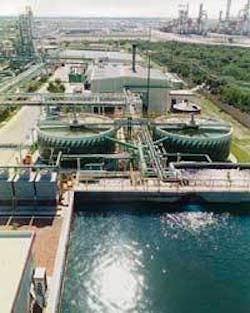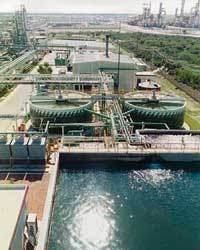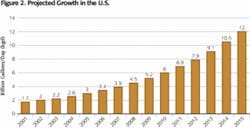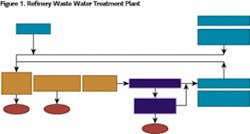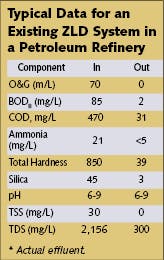Evaluating ZLD Options: Water Scarcity Raising Refineries’ Interest in Water Reuse, Recycling
Water scarcity is fast becoming a problem for both developed and developing countries alike. Simultaneous increases and shifts in population combined with growing industrial activity worldwide are setting public and private users for potable water supplies on a collision course that will likely result in rising prices for this precious, finite commodity for those who are actually able to obtain it.
In 2003, as part of its “International Year of Freshwater,” UNESCO stated that “Water use is increasing everywhere. The world’s six billion inhabitants are already appropriating 54% of all the accessible freshwater contained in rivers, lakes and underground aquifers. By 2025, humankind’s share will be 70%.”
UNESCO also estimated that each year, 23% of all water withdrawn globally is utilized for industrial purposes. The average, however, varies greatly between regions. In Africa, for instance, UNESCO noted, water use for industry accounts for 5% while in Europe, its 54%.
In many industrialized countries, the growing demand for this scarce resource will likely result in more governmental agencies developing mandatory reuse policies and demanding discharged water is returned to the environment cleaner than in the past. As with any resource that’s in short supply, the price of freshwater is likely to rise in the future, making water reuse and recycling more attractive in the long-term. According to the WateReuse Association, water reuse in the United States alone is expected to rise from 2.6 billion gallons per day (bgd) in 2004 to an estimated 12 bgd by 2015.
Reclaiming a Valuable Resource
Dirty process water can become a valuable resource once again through recycle and reuse. Water recycling creates a closed loop of water use and treatment with reinsertion back into the same process, while water reuse involves the reinsertion of treated wastewater from one process into another process.
There are several methods for generating recycled water from wastewater. One of these is “zero liquid discharge,” or ZLD, a process that does not produce a wastewater stream thereby eliminating the need to discharge liquids into the environment. Instead, this multistage purification system uses evaporation and crystallization, typically operating on reverse osmosis (RO) reject waste, to generate an easily disposable solid waste and recreate a fresh water intake supply for refinery processes.
Power plants have looked toward ZLD as a means of recycle and reuse for years. Refineries, which in the past have considered it an added cost, however, are beginning to consider the potential applications and benefits of this technology.
ZLD Applications
At one refinery in Mexico, the potential of serious water pollution resulting from its operations and a lack of resources to address the pollution posed what seemed to be an insurmountable problem.
This led the petroleum company to search for a way to provide its operations with a high-quality water source while avoiding the environmental degradation that can result from discharging wastewater into the sea.
Earth Tech was contracted to deliver a design-build-finance-operate project that would include the installation of an on-site ZLD system that would provide a solution to this need.
The addition of a ZLD system to the refinery’s wastewater treatment plant processes improved operating conditions in the facility by providing more concentrating cycles and increasing the availability of water. As a result, the facility maintained a capacity of 3.5 million gallons a day (mgd) while conserving an average of 2.3 mgd of water, which was reused/recycled from the refinery.
As an added benefit, the site has reduced its impact on local water resources and the environment by redirecting treated wastewater back into the process, instead of releasing it into the environment. The company’s commitment to sustainable water use has improved its public image and created a new one as an environmental supporter.
The methods employed at this refinery are typical of what is being done in more and more plants throughout the world.
What to Consider
In the past, the cost of implementing a ZLD system, including equipment to address crystallization, has deterred many refineries from making an investment. Rising water costs and the simple availability of freshwater in various regions around the world have tipped the scale, making ZLD a potential alternative in certain circumstances. Decreased water consumption and waste discharge, including the permitting that accompanies waste discharge, provide the cost and time savings that can cost justify the use of ZLD in more and more cases.
Petroleum refineries located in regions with limited water resources - such as inland areas of the Middle East - face increasing concerns about the conservation of freshwater supplies. These and other facilities required to meet more restrictive discharge limits or that have a need to expedite the permitting process for a new facility should consider a ZLD system.
The technology’s flexibility and efficiency enables it to be compatible with many systems and adaptable to many uses.
In areas where pollution is a concern, treated water quality can surpass that of freshwater and, depending on the final use, can be used to produce high purity water by adding an additional polishing step to reduce the dissolved solids. An extra RO or ion exchange stage using mixed media may accomplish this.
Before you consider ZLD as an option, there are several questions that should be asked:
• What is the source of water (i.e., well, river...)?
• Are water resources limited?
• What is the unit volume price of the source of water?
• What is the quality and flow of the water coming into the plant?
• What are the desired uses of recycled water (i.e., process applications, cooling towers or boiler water)?
• What is the desired quality and flow of the effluent?
Conclusion
Knowing this information will help you discuss your options with a wastewater professional to determine if ZLD is the right choice for you. The sooner you involve wastewater experts and equipment suppliers in the discussions, the more likely it is they can integrate a reuse or recycling system into your refinery operations.
About the Authors: A licensed professional engineer based in Houston, Michael Romano is business development director for the International Asset Management Group for Earth Tech, a business unit of Tyco International Ltd. He focuses his efforts on the global refinery and petrochemical industry with wastewater and ultrapure water treatment technologies and outsourcing services. With over 25 years of experience in wastewater project management, Enrique Falcon is technical manager for Earth Tech Mexico focusing his efforts on design, build and operate water and wastewater projects globally. Based in Monterrey, Mexico, he’s also a licensed professional engineer. Contact: Michael Romano at (713) 471-7136 or [email protected].
The ZLD Process
A zero liquid discharge process can contain many sequences. A common system might include the following:
• Grease and oil removal through API separator (American Petroleum Institute), Corrugated Plate Interceptor (CPI) and dissolved air floatation (DAF) unit.
• Organic matter and nutrient removal through an activated sludge process.
• Hardness and/or silica removal through a physical chemical process (lime softening), are required in some regions where high contents of these components in water quality could limit recovery efficiency for reverse osmosis (RO), followed by acid or CO2 to adjust pH to a neutral value (7.0).
• Disinfection through ultraviolet or chlorine addition, which requires further dechlorination to avoid damage to the membranes.
• Filtration - conventionally sand, but can be ultrafiltration or microfiltration - to keep TSS consistently low and extend the life of RO membranes by decreasing the amount of cleaning needed.
• RO, which is the preferred process, to reduce conductivity and TDS while enabling the process to recover more or less water according to chemical conditions that must be maintained to avoid scaling or biofouling in the membranes.
• Evaporation and crystallization through “brine concentrators,” vertical tubes that evaporate using thermo-compressed steam, to concentrate brine before it is sent to a crystallizer, which operates using a similar principle.
